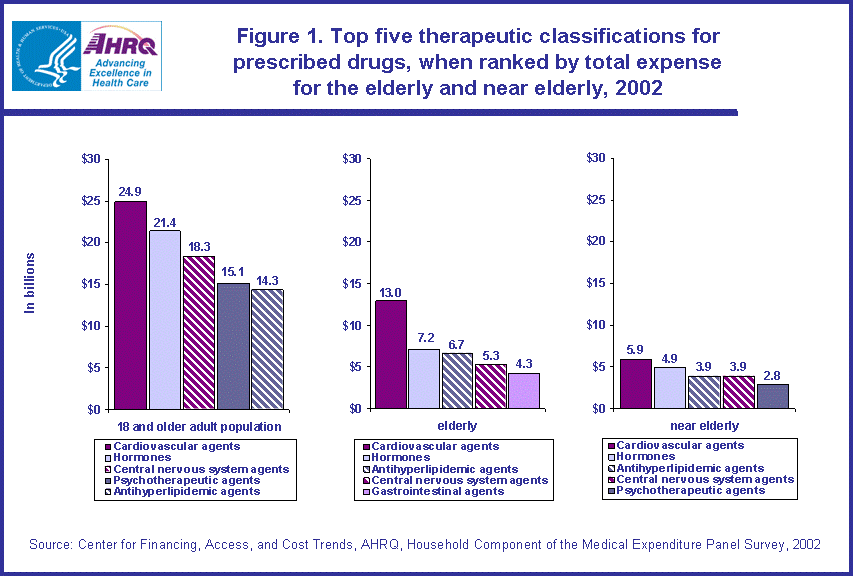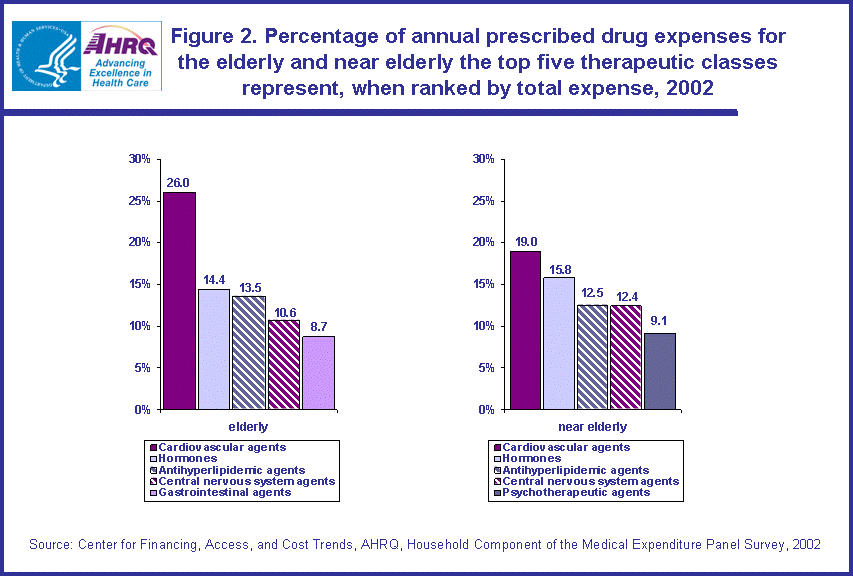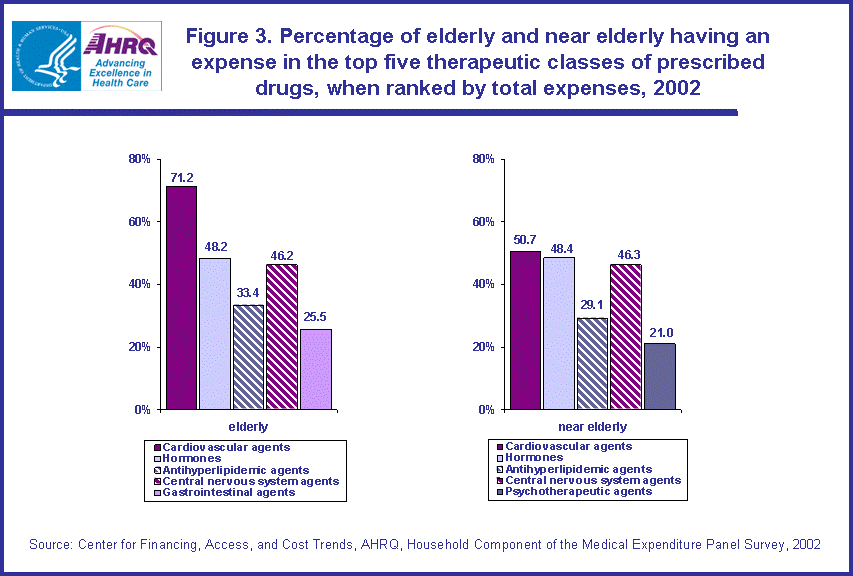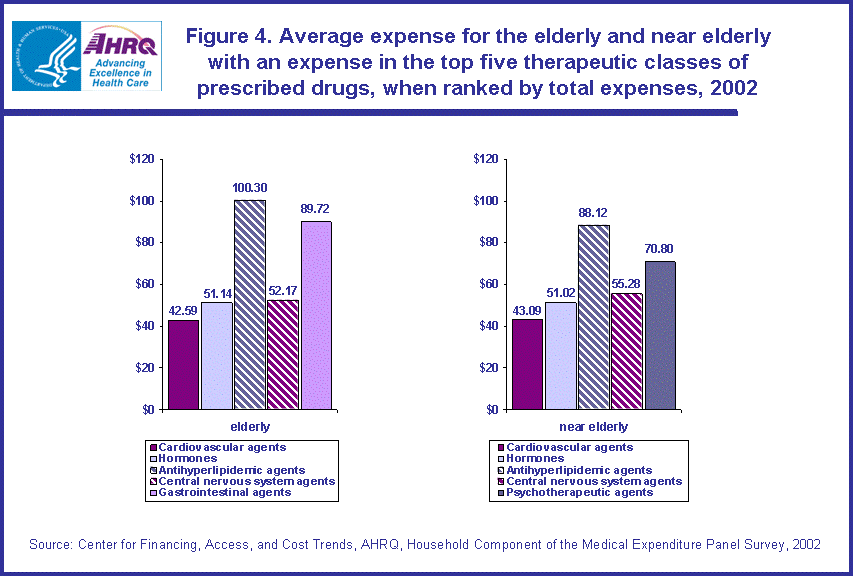
|
|
Font Size:
|
||||
|
|
|
|
||||
STATISTICAL BRIEF #91:
The Top Five Therapeutic Classes of Outpatient Prescription Drugs, by Total Expenses for the Elderly and Near Elderly in the U.S. Civilian Noninstitutionalized Population, 2002
Highlights
- In 2002, the first four of the top five therapeutic classes of prescription drugs were the same for the elderly and near elderly (one, cardiovascular agents; two, hormones; three, antihyperlipidemic agents; four, central nervous system agents).
- The top five therapeutic classes of prescription drugs represented 73.1 percent of the $49.9 billion spent by the elderly on prescription drugs and 68.8 percent of the $31.1 billion spent by the near elderly on prescription drugs in 2002.
- In 2002, cardiovascular agent prescription medicine expenses accounted for approximately one-quarter of total prescription drugs expenses for the elderly (26.0 percent) and nearly one-fifth of total expenses for the near elderly (19.0 percent).
- Over 70 percent of the elderly had a cardiovascular agent expense (71.2 percent) and about half of the near elderly had such an expense (50.7 percent) in 2002.
- In 2002, antihyperlipidemic agents had the highest average expense for the elderly and near elderly, when comparing mean expenses for the top five therapeutic classes ranked by total expenses ($100.30 and $88.12, respectively).
Introduction
This Statistical Brief provides a summary of the top five therapeutic classes of outpatient prescription drugs for the elderly (age 65 and older) and the near elderly (age 55-64), when ranked by total expenses, as reported by households in the U.S. civilian noninstitutionalized population in calendar year 2002. The brief also provides estimates for the elderly and the near elderly on the percentage of total prescribed drug expenses the top five therapeutic classes represent, the percentage having an expense in these classes of drugs, and the mean expenses in these classes of drugs for those with an expense.
The estimates in this brief are derived from the Household Component of the 2002 Medical Expenditure Panel Survey (MEPS-HC). Over-the-counter drugs and free samples are not included in these estimates. All results discussed are statistically significant at the 0.05 level.
Findings
Elderly
In 2002, the top five therapeutic classes for prescribed drugs purchased by the elderly age 65 and older, when ranked by annual expenses, totaled $36.5 billion and represented 73.1 percent of the $49.9 billion total expenses by the elderly (persons age 65 and older) for prescription drugs (estimates not shown). Cardiovascular agents ranked first in terms of total expenses at $13.0 billion, which was higher than total expenses spent on any of the remaining top two to five therapeutic classes: hormones ($7.2 billion), antihyperlipidemic agents (6.7 billion), central nervous system agents (5.3 billion), and gastrointestinal agents (4.3 billion). (figure 1)
In 2002, expenses on cardiovascular agents represented 26.0 percent of total expenses spent on prescription drugs by the elderly, which was higher than the percentages for hormones (14.4 percent), antihyperlipidemic agents (13.5 percent), central nervous system agents (10.6 percent), and gastrointestinal agents (8.7 percent). The percentage of total expenses spent on hormones by the elderly (14.4 percent) was greater than the total expenses spent on central nervous system agents (10.6 percent) and gastrointestinal agents (8.7 percent). Furthermore, the percentage of total prescription drug expenses by the elderly spent on antihyperlipidemic agents (13.5 percent) was higher than the percentage spent on central nervous system agents (10.6 percent) and gastrointestinal agents (8.7 percent). (figure 2)
In 2002, the percentage of the elderly population that used a drug in the top five therapeutic classes of prescription drugs, when ranked by total expenses, was highest for cardiovascular agents. Over 70 percent of the elderly (71.2 percent) used a cardiovascular agent, which was higher than the percentages using prescription drugs in any of the remaining top five therapeutic classes (hormones, 48.2 percent; antihyperlipidemic agents, 33.4 percent; central nervous system agents, 46.2 percent; and gastrointestinal agents, 25.5 percent). Central nervous system agents were fourth in terms of total expenses spent on prescription drugs by the elderly, and a higher percentage of the elderly purchased those types of drugs (46.2 percent) than antihyperlipidemic agents (33.4 percent) or gastrointestinal agents (25.5 percent), which ranked third and fifth, respectively, in terms of total expenses. The percentage of the elderly using hormones (48.2 percent) was higher than those using antihyperlipidemic agents (33.4 percent) and gastrointestinal agents (25.5 percent), and the percentage using antihyperlipidemic agents (33.4 percent) was higher than the percentage using gastrointestinal agents (25.5 percent). (figure 3)
Of the top five therapeutic classes, when ranked by total expenses for the elderly in 2002, antihyperlipidemic agents had a higher mean expense ($100.30) than cardiovascular agents ($42.59), hormones ($51.14), or central nervous system agents ($52.17). Gastrointestinal agents had the second highest mean expense at $89.72, which was higher than the mean expense for central nervous system agents ($52.17), hormones ($51.14), and cardiovascular agents ($42.59). Moreover, cardiovascular agents had the lowest mean expense at $42.59, as compared with all other mean expenses of the top five therapeutic classes for the elderly in 2002. (figure 4)
Near elderly
In 2002, the top five therapeutic classes for household-reported prescribed drugs purchased by the near elderly (persons age 55-64), when ranked by annual expenses, totaled $21.4 billion and represented 68.8 percent of the $31.1 billion total expenses for the near elderly for prescription drugs (estimates not shown). Cardiovascular agents ranked first in terms of total expenses on prescription drugs for the near elderly at $5.9 billion, which was higher than total expenses spent on the top three to five therapeutic classes (antihyperlipidemic agents (3.9 billion), central nervous system agents (3.9 billion), and psychotherapeutic agents (2.8 billion), respectively). Total expenses spent on hormones ($4.9 billion, second in top five) was higher than total expenses spent on psychotherapeutic agents by the near elderly ($2.8 billion, fifth in top five). (figure 1)
In 2002, expenses on cardiovascular agents represented 19.0 percent of total prescription drugs expenses for the near elderly, which was higher than the percentage of total drug expenses spent on antihyperlipidemic agents (12.5 percent), central nervous system agents (12.4 percent), and psychotherapeutic agents (9.1 percent). Furthermore, the percentage of total prescription drug expenses spent on hormones (15.8 percent) and antihyperlipidemic agents (12.5 percent) by the near elderly was higher than the percentage spent on psychotherapeutic agents (9.1 percent) in 2002. (figure 2)
In 2002, a higher percentage of the near elderly used cardiovascular agents (50.7 percent) than antihyperlipidemic agents (29.1 percent) and psychotherapeutic agents (21.0 percent), and the percentage using hormones (48.4 percent) was higher than the percentage using antihyperlipidemic agents (29.1 percent) and psychotherapeutic agents (21.0 percent). Moreover, a higher percentage used central nervous system agents (46.3 percent) than antihyperlipidemic agents (29.1 percent) or psychotherapeutic agents (21.0 percent), and a higher percentage used antihyperlipidemic agents (29.1 percent) than psychotherapeutic agents (21.0 percent). (figure 3)
Among the top five therapeutic classes for the near elderly, when ranked by total expenses on prescription drugs in 2002, antihyperlipidemic agents had the highest mean expense ($88.12) as compared with the mean expense for the remaining four classes (cardiovascular agents, $43.09; hormones, $51.02; central nervous system agents, $55.28; and psychotherapeutic agents, $70.80).
Cardiovascular agents had the lowest mean expense at $43.09. The mean expense for psychotherapeutic agents for the near elderly ($70.80) was higher than the mean expense for hormones ($51.02) and central nervous system agents ($55.28). (figure 4)
Definitions
Therapeutic classes were assigned to drugs using Multum Lexicon variables from Cerner Multum, Inc. For additional information on these and other Multum Lexicon variables, as well as the Multum Lexicon database itself, please refer to the following Web site: http://www.multum.com/Lexicon.htm.
About MEPS-HC
MEPS-HC is a nationally representative longitudinal survey that collects detailed information on health care utilization and expenditures, health insurance, and health status, as well as a wide variety of social, demographic, and economic characteristics for the civilian noninstitutionalized population. It is cosponsored by the Agency for Healthcare Research and Quality and the National Center for Health Statistics.
For more information about MEPS, call the MEPS information coordinator at AHRQ (301-427-1656) or visit the MEPS Web site at http://www.meps.ahrq.gov/.
References
For a detailed description of the MEPS survey design, sample design, and methods used to minimize sources of nonsampling error, see the following publications:
Cohen, J. Design and Methods of the Medical Expenditure Panel Survey Household Component. MEPS Methodology Report No. 1. AHCPR Pub. No. 97-0026. Rockville, Md.: Agency for Health Care Policy and Research, 1997.
Cohen, S. Sample Design of the 1996 Medical Expenditure Panel Survey Household Component. MEPS Methodology Report No. 2. AHCPR Pub. No. 97-0027. Rockville, Md.: Agency for Health Care Policy and Research, 1997.
Cohen, S. Design Strategies and Innovations in the Medical Expenditure Panel Survey. Medical Care, July 2003: 41(7) Supplement: III-5-III-12.
Suggested Citation
Stagnitti, M. N. The Top Five Therapeutic Classes of Outpatient Prescription Drugs, by Total Expenses for the Elderly and Near Elderly in the U.S. Civilian Noninstitutionalized Population, 2002. Statistical Brief #91. July 2005. Agency for Healthcare Research and Quality, Rockville, Md. http://meps.ahrq.gov/mepsweb/data_files/publications/st91/stat91.shtml
 |
||||||||||||||||||||||||||||||||||||||||||||||||
|
||||||||||||||||||||||||||||||||||||||||||||||||
|
|
||||||||||||||||||||||||||||||||||||||||||||||||
 |
||||||||||||||||||||||||||||||||||||||||||||||||
|
||||||||||||||||||||||||||||||||||||||||||||||||
|
|
||||||||||||||||||||||||||||||||||||||||||||||||
 |
||||||||||||||||||||||||||||||||||||||||||||||||
|
||||||||||||||||||||||||||||||||||||||||||||||||
|
|
||||||||||||||||||||||||||||||||||||||||||||||||
 |
||||||||||||||||||||||||||||||||||||||||||||||||
|
||||||||||||||||||||||||||||||||||||||||||||||||
|
|
||||||||||||||||||||||||||||||||||||||||||||||||


